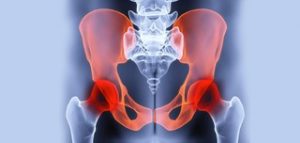What is persistent pelvic pain?
Persistent pelvic pain (PPP) is persistent or recurrent pain located below the abdomen, around the pelvis either internally or externally, that you have experienced for a minimum of six months. One in four women will experience PPP and only one quarter of these women will seek help.
What are the symptoms of PPP?
- Pain around the pelvic area, groin, hips or lower back
- Stabbing pains in the abdomen
- Referred pain to other areas of the body
- Pain during or after intercourse
- Pain or difficulty inserting a tampon
- Vulvar pain
- Feeling pain with movements or activities that previously were not painful
- Leakage of urine when coughing, sneezing, laughing or lifting
- Sudden or immediate urge to go to the toilet
- Increased frequency of going to the toilet
- Constipation
- Feeling the need to strain while on the toilet
- Irritable bowel
- Bloating
- Discomfort wearing tight clothing
- Fatigue, anxiety, depression
- Dizziness or sweating

What causes PPP?
PPP can be caused by the following conditions:
- Endometriosis
- Dyspareunia (pain with intercourse)
- Vaginismus (pelvic floor muscle spasm)
- Vulvodynia (pain around the vulva)
- Interstitial cystitis or painful bladder syndrome
- Recurrent episodes of thrush
- Sporting injuries of the pelvis, lower back or hips
Often there is no obvious pathology present that is causing your pain (your test results may be clear). It may feel confusing as to why you are experiencing the pain and feel like you have no answers. The causes of PPP is multifactorial and involves the interaction between the central nervous system and the pelvic floor muscles and nerves.
When you have experienced ongoing pain for some time, the muscles and nerves in your body can become hypersensitive, which means they become tight and sore. Movements or sensations that are usually pain free, start to become painful. Movements or sensations that were already painful, become even more painful. This means your body is in a state called central sensitisation. This can occur with any part of the body and is very common in women with PPP. Through pelvic floor physiotherapy, you can desensitise your muscles and nerves to regain pain free movement and sensations.
What do you do if you are experiencing PPP?
PPP is a very complex condition which involves a multi-disciplinary approach for treatment. Seeking help from your pelvic floor physiotherapist, general practitioner or specialist health professional will enable you to seek appropriate treatment. Pelvic floor physiotherapy has been proven to be safe and helpful in treating PPP.
What will a pelvic floor physiotherapy assessment involve?
Your pelvic floor physiotherapist will complete a thorough history to understand your pain, your concerns and how this is affecting your life. Followed by a detailed examination of the relevant structures to determine an appropriate, individualised treatment program. Depending on your comfort levels and wishes, this may include an internal and/or external examination.
What are the pelvic floor physiotherapy treatment options?
- Stretches and relaxation for the pelvic, hip and lower back muscles
- Heat or cold packs for pain relief
- Massage or trigger point release of tight muscles
- Breathing techniques
- Pelvic floor muscle strength, co-ordination and endurance exercises
- Discussing strategies to improve your bladder and bowel symptoms e.g. ways to defer a sudden urge to go to the toilet or ways to prevent leakage when you cough
- Discussing postures to avoid straining on the toilet
How can pelvic floor physiotherapy help?
- Improve pain management
- Give you strategies to use during a pain flare and ways to prevent a pain flare
- Help you understand the causes of your pain. Evidence indicates that you can decrease your pain levels simply by understanding the reasons why you are experiencing pain. This can also improve stress and anxiety.
- Improve flexibility of your pelvis, hips and lower back
- Strengthen your muscles
- Relaxation of tight muscles
- Assist with bladder or bowel symptoms
- Help with incontinence
- Improve your posture
- Improve your quality of life and overall wellness
- Help you return to exercise
- Empower you to achieve your goals
Do I need a referral to see a pelvic floor physiotherapist?
No, you do not need a referral. If you do have any correspondence or previous test results, please bring them along to your appointment.

~Julia Raptis (Esposito)
If you are experiencing any of the above symptoms or have any concerns regarding pelvic pain, please book a pelvic floor physiotherapy appointment. Julia Raptis (Esposito) is our onsite pelvic floor physiotherapist, and she is available Monday to Friday and on the occasional Saturday.
References:
Berghmans, B. (2018). Physiotherapy for pelvic pain and female sexual dysfunction: an untapped resource. International Urogynecology Journal, 29(5), 631-638. doi:10.1007/s00192-017-3536-8
Bo, K., Frawley, H. C., Haylen, B. T., Abramov, Y., Almeida, F. G., Berghmans, B., . . . McClurg, D. (2017). An International Urogynecological Association (IUGA)/International Continence Society (ICS) joint report on the terminology for the conservative and nonpharmacological management of female pelvic floor dysfunction. International Urogynecology Journal, 28(2), 191-213.
Evans, S. (2015). Management of persistent pelvic pain in girls and women. Australian family physician, 44, 454-459. Retrieved from http://www.racgp.org.au/afp/2015/july/management-of-persistent-pelvic-pain-in-girls-and-women/
Evans, S. (2019). Introduction to pelvic pain(pp. 1-20). Retrieved from https://www.pelvicpain.org.au/wp-content/uploads/2019/02/Introduction-to-Pelvic-Pain-2019.pdf
Laursen, B. S., Bajaj, P., Olesen, A. S., Delmar, C., & Arendt‐Nielsen, L. (2005). Health related quality of life and quantitative pain measurement in females with chronic non‐malignant pain. European journal of pain, 9(3), 267-267.
Zondervan, K. T., Yudkin, P. L., Vessey, M. P., Jenkinson, C. P., Dawes, M. G., Barlow, D. H., & Kennedy, S. H. (2001). The community prevalence of chronic pelvic pain in women and associated illness behaviour. Br J Gen Pract, 51(468), 541-547.

